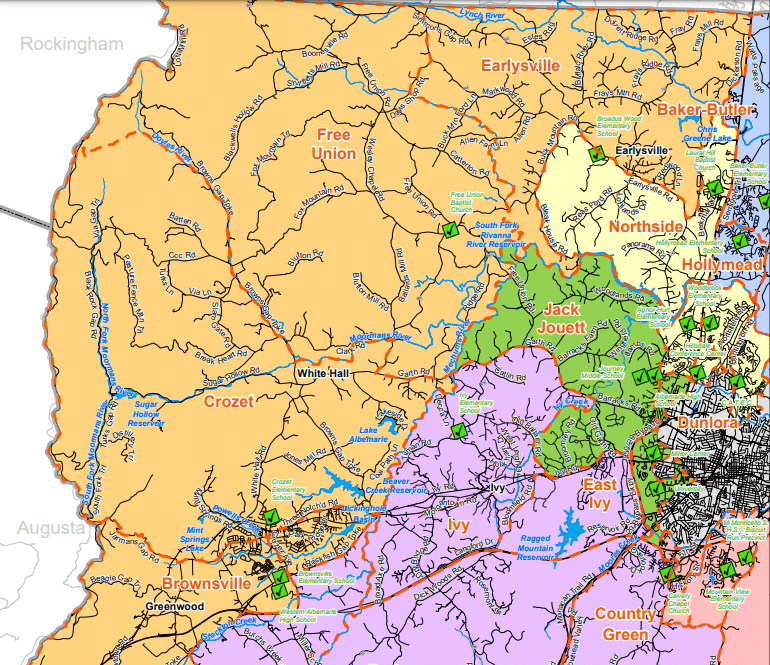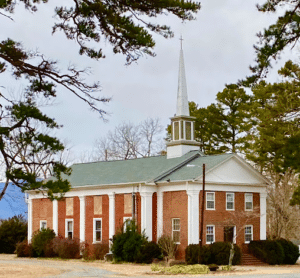White Hall Charlottesville Real Estate
358 CLAREMONT LN CROZET, Virginia
5 Beds 4 Baths 5,260 SqFt 0.35 Acres
7035 BLACKWELLS HOLLOW RD CROZET, Virginia
3 Beds 3.5 Baths 2,500 SqFt 22.14 Acres
145 AGATHA RIDGE LN CROZET, Virginia
5 Beds 3.5 Baths 3,113 SqFt 0.26 Acres
6696 HIGHLANDER WAY CROZET, Virginia
3 Beds 2.5 Baths 3,950 SqFt 42.03 Acres
804 GOLF VIEW DR CROZET, Virginia
4 Beds 3.5 Baths 2,859 SqFt 0.11 Acres
101 MILLER SCHOOL RD CROZET, Virginia
3 Beds 2.5 Baths 2,919 SqFt 2.61 Acres
1769 OLD TRAIL DR CROZET, Virginia
5 Beds 3.5 Baths 4,010 SqFt 0.24 Acres
White Hall Virginia real estate is a rare commodity and not usually entered into the Charlottesville MLS as White Hall but…as Crozet real estate. White Hall is located in the northwest area of Albemarle County.
Recently Sold White Hall Virginia Real Estate
6788 ROCKFISH GAP TPKE CROZET, Virginia
4 Beds 2 Baths 4,059 SqFt 7.31 Acres
6933 WINDMERE LN CROZET, Virginia
6 Beds 4.5 Baths 4,208 SqFt 0.46 Acres
814 ARBOLEDA DR CROZET, Virginia
5 Beds 4.5 Baths 3,855 SqFt 0.14 Acres
657 JONNA ST CROZET, Virginia
5 Beds 4.5 Baths 4,548 SqFt 0.49 Acres
6111 ROTHWELL LN CROZET, Virginia
5 Beds 4.5 Baths 4,296 SqFt 0.65 Acres
124 SAN MARCOS WAY CROZET, Virginia
5 Beds 4.5 Baths 5,133 SqFt 0.48 Acres
7680 BIRCHWOOD HILL RD CROZET, Virginia
5 Beds 3.5 Baths 4,140 SqFt 0.46 Acres
136 AGATHA RIDGE LN CROZET, Virginia
4 Beds 4.5 Baths 3,404 SqFt 0.25 Acres
7127 BRADBURY CT CROZET, Virginia
5 Beds 4 Baths 3,431 SqFt 0.48 Acres
6105 ROTHWELL LN CROZET, Virginia
4 Beds 3.5 Baths 3,505 SqFt 0.65 Acres
3475 ROWCROSS ST CROZET, Virginia
4 Beds 3.5 Baths 3,346 SqFt 0.18 Acres
5237 PARK RIDGE CT CROZET, Virginia
6 Beds 5 Baths 4,586 SqFt 0.2 Acres
606 SAUNDERS HILL DR CROZET, Virginia
4 Beds 4.5 Baths 4,016 SqFt 0.14 Acres
120 BISHOPGATE LN CROZET, Virginia
4 Beds 3.5 Baths 2,774 SqFt 0.09 Acres
5608 PARK RD CROZET, Virginia
4 Beds 3.5 Baths 2,913 SqFt 0.52 Acres
6658 WELBOURNE LN CROZET, Virginia
5 Beds 6.5 Baths 6,458 SqFt 0.46 Acres
3433 CEMETERY KNL CROZET, Virginia
3 Beds 3.5 Baths 3,678 SqFt 7.07 Acres
120 AGATHA RIDGE LN C CROZET, Virginia
4 Beds 4.5 Baths 3,404 SqFt 0.25 Acres
White Hall’s main attraction is Sugar Hollow Reservoir and the wonderful trails that lead into the Shenandoah National Forest. The Moormans River and Doyles River flow through the area and is great trout fishing.

There are a few vineyards nearby the two most popular being Grace Family Vineyards and White Hall Vineyards. White Hall Vineyards is for sale for $5,500,000 and 37.5 acres or…purchase White Hall Vineyards in its entirety for $12,000,000 and 210 acres. I prefer White Hall’s wines to Grace Family Vineyards.
White Hall is a cross roads village located on the old Brown’s Gap Turnpike, one of the earliest in Albemarle County, and according to tradition the village took its name from an inn that operated along this route by the White family in the early nineteenth century. Browns Gap Turnpike begins at the intersection of Rt 240 and Rt 250 just west of Ivy. It continues over the Blue Ridge Mountains into Rockingham County. It is undriveable at it gets into the mountains. But a lovely hike.

White Hall History
By 1835, White Hall had become the established name for the community. Prior to that it had been an election precinct under the successive names of Glenn’s Store, William Maupin’s Store, Maupin’s Tavern, Miller’s Tavern and Shumate’s Tavern.
Early Settlement (1607-1789)
Settlement in the White Hall area began in the 1730s when it was still part of Goochland County. The earliest land patent on the Moorman’s River was recorded by David Mills in 1739 for 2,850 acres on its north fork. In 1741, Dennis Doyle was granted 800 acres along the same stream which came to be called Doyle’s River. The same year, Thomas Moorman patented land lower down the river, hence the name applied to the main branch today.
There were two Moorman land grants on Moormans River in 1735. The “Indian graves lowgrounds” grant to Thomas which was on Moormans River north of Owensville.
There was also a land grant issued 10 Sept 1735 to Charles Moorman in the White Hall area “at a Fork of the Rivanna River under the Blue Mountains.” David Maupin’s earliest surveys and land grants were adjacent to this 400 acre grant. Maupin purchased the tract from Moorman, as he later owned this land, but Albemarle deeds from this period do not survive.
In 1744, the White Hall area was included in the newly formed Albemarle County. Other early land patents in the White Hall area include those acquired by the Jameson family, with patents on the Moorman’s River in 1741 and 1747 and the Mills family, which took out patents between 1744 and 1756 for land along the foot of Bucks Elbow between Crozet and White Hall. The Maupin family, whose descendants still live in this area, first patented land in the area in 1748.
North of White Hall, towards the Blue Ridge, the Brown family entered patents between 1747 and 1760 for over six thousand acres on both sides of the Doyle River. Brown’s Cove and Brown’s Gap are named for this family.
Settlement in this area of Albemarle County had grown enough by the 1740s to warrant the construction of a road for its residents. Brown’s Gap Road, in existence by 1745, followed the approximate course of today’s Route 810 as it continues north out of the village toward the Blue Ridge Mountains.
Brown’s Gap Road was an early route for Shenandoah Valley farmers who crossed the Blue Ridge Mountains and traveled through Albemarle County with their produce to such James River ports as Scottsville. There, produce was shipped to Richmond and Tidewater via the James River.
Today’s Route 614 through White Hall was a part of the old Buck Mountain Road, which by 1783 connected Stony Point in the eastern part of Albemarle County to the area around Crozet, south of White Hall. The eastern part of the road was laid in 1742, extending from present day Louisa County to Rocky Creek, between Free Union and White Hall.
Loss of records makes it difficult to determine precisely when it was extended to the west, but by 1783, and probably much earlier, the road ran through the White Hall area.
During the colonial period, the Anglican Church was the official religion in Virginia. Nevertheless, several different religious sects were represented in Albemarle County.
Methodists apparently established themselves in the White Hall area in the 1780s. The forerunner of Mt. Moriah Methodist Church in White Hall is first mentioned in a 1788 deed, and was thus the home of the first Methodist meeting in the county.
Early National Period (1789-1830)
The Brown’s Gap Road became an increasingly important transportation artery during this period, stimulating economic growth in the community. In 1805, William Jarman and Brightberry Brown, acting under the authorization granted by the First Assembly five years earlier, upgraded the old Brown’s Gap Road to a turnpike, the first in Albemarle County. This road was an important link for Shenandoah Valley farmers to shipping points on both the Rivanna and James Rivers.
The name “White Hall” is believed to derive from an inn built on this road which was once owned by the White family. The present White Hall building may or may not be this inn, although architectural evidence indicates an early nineteenth century date of construction. It has been added to considerably over its history and has served as the village post office, a school, and a doctor’s office.
Farmers in the surrounding area grew a variety of crops during this period, although cereal grains predominated. White Hall served not only as a way station for travelers on the Brown’s Gap Turnpike, but as a local trading center for the surrounding farms.
Beginning in 1829, a post office appeared under the name of Moorman’s River in postal directories, located in or near present-day White Hall.
An early house in White Hall is the Wyant House, a tall two-story gable-roofed house that may date from the late 18th century.
A store has been associated with this house since the early 19th century, although the present Wyant’s Store, dates from the early 20th century. The earliest section of Piedmont, located west of the Wyant House, also dates from the early 19th century.
In 1825, a German traveler and diarist, the Duke of Saxe-Weimar-Eisenach, described traveling the Brown’s Gap Turnpike west from Weyer’s Cave to Charlottesville, noting that once he had crossed the mountains “the road became less hilly…but nevertheless the road continued to be very rough, and we were badly shaken up before we reached Charlottesville.”
It took his party nearly eight hours to travel from Brown’s Cove to Charlottesville.
Antebellum Period
White Hall continued to rely on traffic along the busy Brown’s Gap Turnpike for much of its livelihood. The Piedmont Store was built sometime between 1847 and 1853 by the Maupin family, although it may have been incorporated and earlier building.
The Methodist congregation in White Hall grew considerably during the antebellum period. In 1834, a lot for a new church was given by the Maupin family. The present Mt. Moriah Methodist Church was built soon after. A portion of the present church dates from 1834, although it was significantly enlarged and remodeled in 1854. It has been altered several times since then. A typical classical brick meeting house from this period, it resembles such churches as Free Union Baptist Church and Batesville Methodist Church.
In its early history, the church was known as Maupin’s Meeting House.
White Hall Virginia During The Civil War
Albemarle County saw little military activity during the Civil War, and no engagements were found in the White Hall area. The Brown’s Gap Turnpike, however, was a major route for troops traveling east from the Shenandoah Valley to the Piedmont.
Wilbur Fisk Davis, whose father was minister at Mount Moriah Church, was a resident of White Hall during the early days of the Civil War and in his reminiscences recorded some of the villagers’ activities:
“Day after day the men of the Village met in the P.O. at Maupin’s Store at mail time. The daily Richmond paper was taken out and I acted as reader to the listening crowd. The Holcomb Guards – volunteer company was organized at once and began to drill. The ladies of the vicinity united in making uniforms for them, meeting for the purpose in the rooms above the store. The company was soon mustered into service as part of the 7th Va. Regiment.
We home guards took to patrolling the community at night to see that the negroes were in their homes and quiet and also to look after any disaffected whites. The negroes were invariably found all right and always at home. Going when we would, after a few weeks becoming satisfied that they had no idea of any insubordination.”
In May 1862, Stonewall Jackson, along with about half his troops, some 8,500 men, slipped eastward out of the Shenandoah Valley by way of the Brown’s Gap Turnpike and traveled through White Hall on their way to the railroad depot at Mechum’s River.
Jackson and his troops are supposed to have camped on the grounds of Piedmont.
At Mechum’s River, Jackson and his troops boarded trains to slip back into the Valley at Staunton, a maneuver which successfully surprised and confused the enemy.
Reconstruction and Growth (1865-1914)
White Hall was bypassed by the railroad and declined in importance during this period. It remained, however, a small trading community for the surrounding farms and once supported at least three stores, along with a blacksmith shop. Wyant’s Store was built in 1888 by merchant Adam K. Wyant and once housed a social hall on the second floor.
It burned in 1918 and was replaced by the present building.
Although no community by the name of White Hall appears in the 1911 Chataigne’s Directory, there are listings for businesses and churches.

For example, Mount Moriah Methodist Church is listed at Moorman’s River, as is White Hall Episcopal Church (no longer extant), and the community is described as having a population of 30.
Among businesses listed are general merchants E.L. Harris, R.L. Powell and A.K. Wyant; two blacksmiths and wheelwrights; two livestock dealers; two corn and flour mills; four saw mills; a sassafras oil manufacturer; a shingle manufacturer; a tanner; one teacher and one doctor. White Hall’s School for the white students was built in 1906 across the street from Mount Moriah.
The two story concrete school was closed in the 1950s but was recently converted to a residence owned by Clifford Fox, a fellow Charlottesville realtor.
World War I to World War II (1914-1945)
In 1933, a Civilian Conservation Corps (CCC) camp was established near White Hall on Route 614 as a part of the New Deal Relief Program following the Great Depression. In August 1944, this former CCC camp was converted into Camp Albemarle to house about 250 German prisoners of war. About ten to twelve barracks remaining from the CCC camp housed these men, and the main addition to the facility was a high fence with barbed wire at the top and guard towers at the corners.
These prisoners were employed as agricultural laborers for surrounding orchards and farms at a time when the labor shortage was severe. The last occupants left the camp in May of 1946, and the buildings deteriorated. By the mid-1950s almost all the structures were removed from the site.
